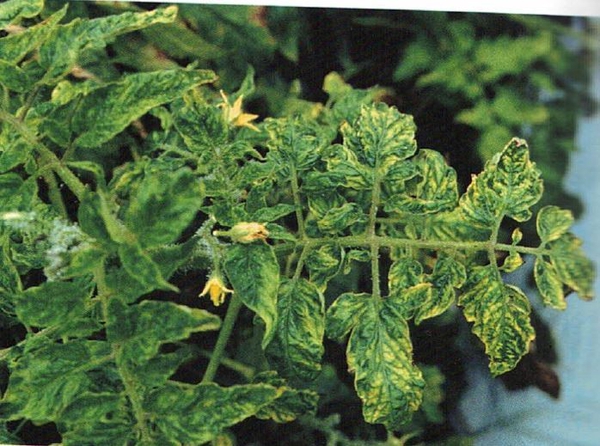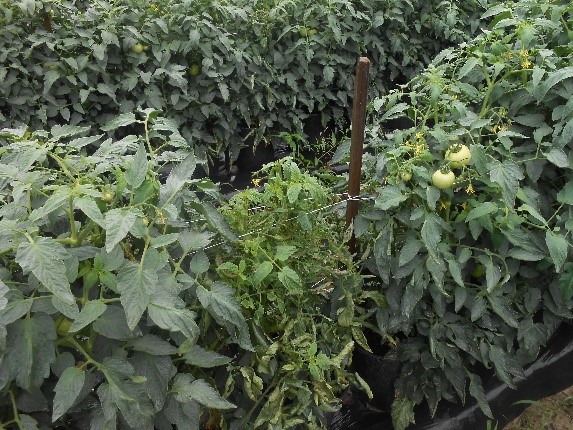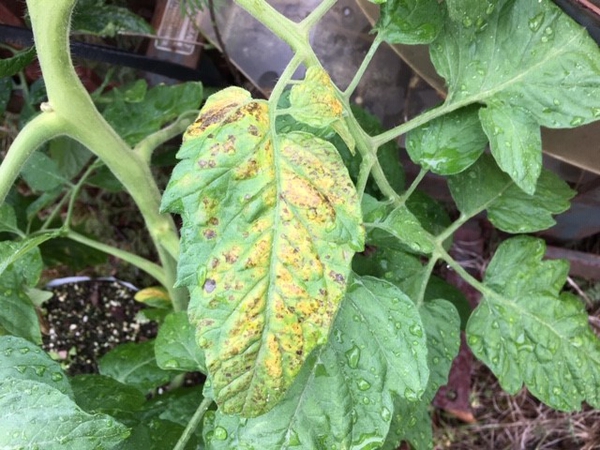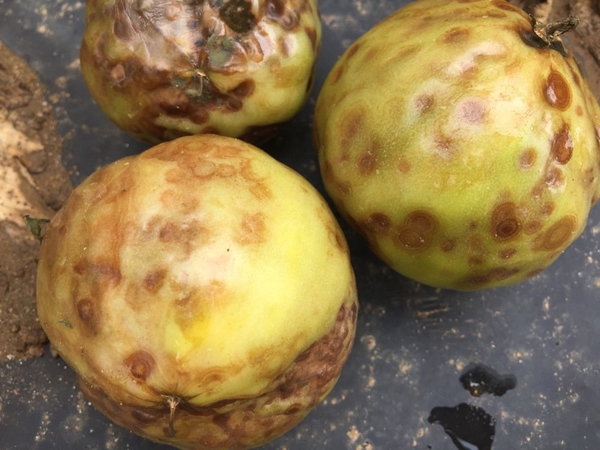General Information
Viral diseases of greenhouse tomatoes in North Carolina occasionally cause serious damage and large economic loss. The amount of loss can vary depending on the virus disease involved, the variety of tomato, the age of the plant at infection time, the temperature during disease development, the presence of other diseases, and the extent that viruses have spread in the planting. The dense plant spacing, closed environment, and frequent mechanical contact that is inherent to greenhouse tomato production increase the chances of a viral disease outbreak. The symptoms, hosts, and means of spread of viral diseases that may be problematic in North Carolina are summarized in Table 1. Keep in mind that symptoms will vary by strain of virus, age and health of host upon infection, and environmental conditions. The first step in controlling a disease is identifying the causal agent. For an accurate diagnosis of viral diseases, contact your local horticultural extension agent to send a sample to the Plant Disease and Insect Clinic at NC State University.
Pathogens
|
Virus |
Symptoms |
Hosts |
Sources |
Means of spread |
|
Tobacco Mosaic (TMV) |
Dark green/yellow leaf mottling, stunting, leaf curl and malformation, poor fruit set and small fruit |
Pepper, tobacco, petunia, horsenettle, jimsonweed, Jerusalem cherry, nightshade, ground cherry, plantain, others |
Infected seed, plant debris, dried tobacco products, perennial weeds |
Contact via hands, tools, plant material, seed |
|
Tomato Spotted Wilt (TSWV) |
Chlorosis and bronzing of leaves, stem streaking, stunting, wilting, chlorotic ringspots on fruit |
Many weeds, vegetables, ornamentals, tobacco, soybeans |
Weeds, ornamentals |
Thrips |
|
Cucumber Mosaic (CMV) |
Leaf mottling, yellowing, stunting, leaf twisting and elongation (“shoestring”), poor fruit set and small fruit |
Weeds, flowers, vegetables, milkweed, ground cherry, horsenettle, pokeweed, jimsonweed, marigold, petunia, zinnia, cucumber, melons, celery, pepper, others |
Weeds, flowers
|
Aphids |
|
Potato Virus Y (PVY) |
Faint mottling and leaf distortion, yellowing along veins, petioles curve downward, purple streaking on stems |
Solanaceous and leguminous plants |
Potato and pepper plants, weeds
|
Aphids |
|
Double Streak (TMV + CMV) *Potato virus X may also be involved |
Usually affects large plants, dwarfed, spindly appearance, rolling and withering of leaves. Long brown streaks on petioles and stems. Irregular ripening of fruit, light brown sunken spots on green fruit |
Same as for TMV and CMV |
Same as for TMV and CMV |
Same as for TMV and CMV |
|
Tobacco Etch (TEV) |
Intense mottling, puckering, stunting, small and mottled fruit and |
Solanaceous and leguminous plants |
Potato and pepper plants, weeds, horsenettle |
Aphids
|
|
Tobacco and tomato ringspot (TRSV) |
Ringspot or zigzag lines on foliage, occasionally on stems, petioles, and fruit |
Many weeds, vegetables, ornamentals, tobacco, soybeans |
Weeds, seed |
Dagger nematode, thrips, mites, grasshopper, flea beetles |
|
Tomato aspermy (TAV) |
Death of terminal tips, branching, bushy appearance, distorted and seedless fruit |
Solanaceous plants, lettuce, spinach, weeds and many others |
Weeds |
Aphids |
Other threats. Though it has not yet been detected in North Carolina, the Tomato brown rugose fruit virus (ToBRFV) was first detected and eradicated in the United States in 2018 and its spread is currently being closely monitored by the USDA Animal and Plant Health Inspection Service (USDA-APHIS). Peppers, eggplants, tomatoes, and cut-leaf ground cherry are all hosts of the virus. It is transmitted by seed and spreads easily via mechanical contact. Symptoms often do not show up until fruit begins to ripen, but symptoms may include mosaic patterns on leaves, leaf narrowing, necrotic pedicles, calyces, and petioles, and smaller, discolored fruit that ripens later. As of 2020, USDA-APHIS is currently inspecting tomato and pepper seed, plant material, and fruit imported from countries where the virus has been diagnosed. If you suspect that you may have this virus in your greenhouse, contact your local Extension agent.
Lookalike diseases. Symptoms of viral diseases may be similar to those caused by abiotic disorders, including nutritional disorders or herbicide injury.
Disease Cycle and Epidemiology
With the exception of TMV, most viruses attacking tomatoes survive only in living plants or briefly in insects, and are spread primarily by insects. Very few viruses are seed-borne. Tobamoviruses, including TMV and tomato brown rugose virus, can spread easily through mechanical transmission. These viruses can live on seed and can persist in the soil for long periods of time.
Disease Management for Commercial Growers
Control of viruses on tomato requires a complete program that is implemented all year.
Resistant varieties. When possible, plant resistant or tolerant varieties. There are varieties that have varying levels of resistance or tolerance to certain strains of TMV and TSWV.
Use clean seed. Obtain seed from reputable sources. Look for procedures such as fermentation or treatment with acid or bleach by the seedsman. If seed has not been treated, you can treat it yourself. Instructions can be found in the Southeastern US Vegetable Crop Handbook. There are several important things to keep in mind if treating seed yourself: (1) Beginners should try this seed treatment on a small number of seed prior to treating large lots; (2) Seed germination may be reduced with some lots of seed; (3) Research has shown that this seed treatment is enhanced by prewashing the seed for 15 minutes in a solution of trisodium phosphate (one ounce of TSP in two quarts of water); (4) Do not re-contaminate the seed by placing in used containers.
Sanitation. For transplant production, seed in individual pots (peat pots, etc.) and do not touch or handle plants prior to setting in the greenhouse. Discard pots with seedlings that show leaf twisting, mosaic, or unusual growth. Do not touch other seedlings while discarding them. Disinfest equipment, tools, and hands on a regular basis while pulling, pruning, trellising, harvesting, and spraying plants, and when moving from one row or area to another. Decontaminate stakes, tools, tables, etc. by washing them free of debris and then using a sanitizer. Use fresh solutions each time.
Manage insects and weeds. Control thrips and aphids early in the season to reduce initial infection and spread. For information regarding insecticide application, refer to the Southeastern US Vegetable Crop Handbook. All annual weeds in proximal areas should be destroyed. Greenhouses containing tomatoes should be bordered by at least 150 feet of turf or pavement.
Remove diseased plants. Remove and destroy diseased plants early in the season. Do not touch healthy plants with the diseased plants when removing them. Remove and destroy tomato plants as soon as possible after crop termination.
Disease Management for Homeowners
Whenever possible, plant varieties with resistance or tolerance to TMV and / or TSWV. Obtain seeds from a reputable source, and seed in individual pots (peat pots, etc.) and do not touch or handle plants prior to setting in the greenhouse. Discard pots with seedlings that show leaf twisting, mosaic, or unusual growth. Do not touch other seedlings while discarding them.
Control thrips and aphids early in the season to reduce initial infection and spread. Eliminate all weeds in and surrounding the greenhouse. Contact your local horticultural extension agent for information regarding the use of insecticides and herbicides.
Disinfest equipment, tools, and hands on a regular basis while pulling, pruning, trellising, harvesting, and when moving from one row or area to another. This can be done by soaking 10 minutes in a 1:10 dilution of 5.25% sodium hypochlorite (10% Clorox), or by washing in detergent at the concentrations recommended for washing clothes or dishes. Keep in mind that Clorox is corrosive to metal.
Remove and destroy symptomatic plants whenever they appear. Destroy and remove tomato plants at the end of the growing season.
Resources
- The NC State University Plant Disease and Insect Clinic provides diagnostic services and control recommendations
- The NC State Extension Plant Pathology portal provides information on crop disease management
- The Southeastern US Vegetable Crop Handbook provides information on vegetable disease management
Publication date: June 11, 2021
Reviewed/Revised: June 22, 2021
N.C. Cooperative Extension prohibits discrimination and harassment regardless of age, color, disability, family and marital status, gender identity, national origin, political beliefs, race, religion, sex (including pregnancy), sexual orientation and veteran status.





